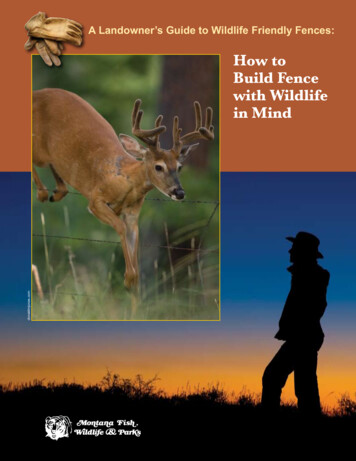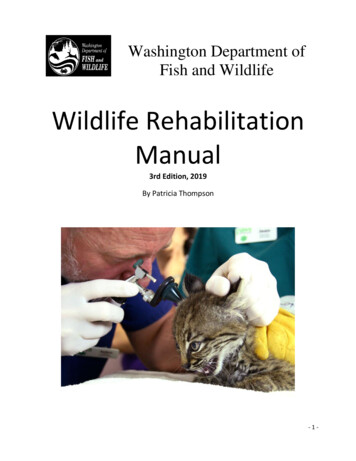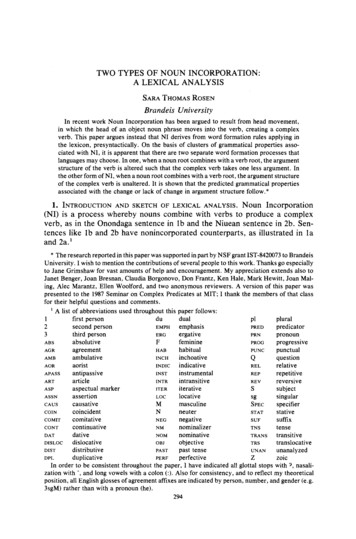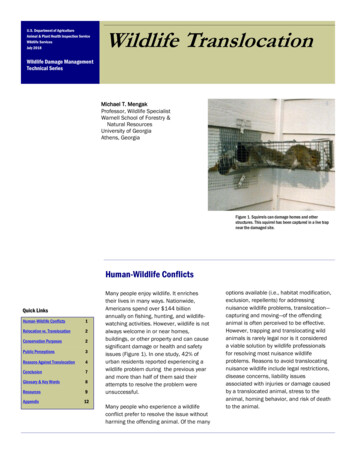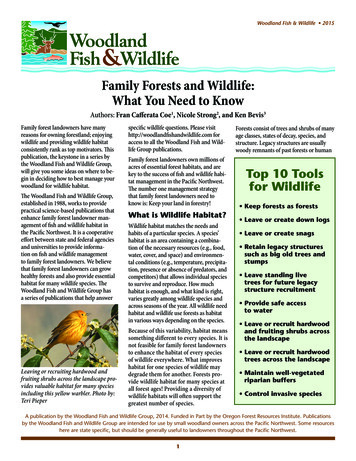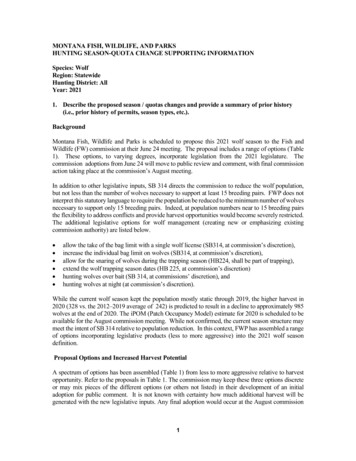
Transcription
MONTANA FISH, WILDLIFE, AND PARKSHUNTING SEASON-QUOTA CHANGE SUPPORTING INFORMATIONSpecies: WolfRegion: StatewideHunting District: AllYear: 20211. Describe the proposed season / quotas changes and provide a summary of prior history(i.e., prior history of permits, season types, etc.).BackgroundMontana Fish, Wildlife and Parks is scheduled to propose this 2021 wolf season to the Fish andWildlife (FW) commission at their June 24 meeting. The proposal includes a range of options (Table1). These options, to varying degrees, incorporate legislation from the 2021 legislature. Thecommission adoptions from June 24 will move to public review and comment, with final commissionaction taking place at the commission’s August meeting.In addition to other legislative inputs, SB 314 directs the commission to reduce the wolf population,but not less than the number of wolves necessary to support at least 15 breeding pairs. FWP does notinterpret this statutory language to require the population be reduced to the minimum number of wolvesnecessary to support only 15 breeding pairs. Indeed, at population numbers near to 15 breeding pairsthe flexibility to address conflicts and provide harvest opportunities would become severely restricted.The additional legislative options for wolf management (creating new or emphasizing existingcommission authority) are listed below. allow the take of the bag limit with a single wolf license (SB314, at commission’s discretion),increase the individual bag limit on wolves (SB314, at commission’s discretion),allow for the snaring of wolves during the trapping season (HB224, shall be part of trapping),extend the wolf trapping season dates (HB 225, at commission’s discretion)hunting wolves over bait (SB 314, at commissions’ discretion), andhunting wolves at night (at commission’s discretion).While the current wolf season kept the population mostly static through 2019, the higher harvest in2020 (328 vs. the 2012–2019 average of 242) is predicted to result in a decline to approximately 985wolves at the end of 2020. The iPOM (Patch Occupancy Model) estimate for 2020 is scheduled to beavailable for the August commission meeting. While not confirmed, the current season structure maymeet the intent of SB 314 relative to population reduction. In this context, FWP has assembled a rangeof options incorporating legislative products (less to more aggressive) into the 2021 wolf seasondefinition.Proposal Options and Increased Harvest PotentialA spectrum of options has been assembled (Table 1) from less to more aggressive relative to harvestopportunity. Refer to the proposals in Table 1. The commission may keep these three options discreteor may mix pieces of the different options (or others not listed) in their development of an initialadoption for public comment. It is not known with certainty how much additional harvest will begenerated with the new legislative inputs. Any final adoption would occur at the August commission1
meeting after public comment is considered. Unless specifically changed by commission adoption,season elements from the 2020 season are proposed and would remain unchanged.Increase of Harvest Potential for Each ToolWithin these options, specific tools described below each represent relative different and unknownpotential for increased harvest of wolves. These differences may variously contribute to thecommission’s interest to be less or more aggressive in their pursuit of a legislatively required wolfpopulation reduction. While SB 314 speaks to a conditioned reduction of wolves, it does not speak toa specific timeline for that reduction to be achieved. While some participants in legislative hearingsadvocated rapid reduction of the wolf population to address concerns about game numbers (particularlyin northwest/western MT where wolves are abundant, and some elk populations are below objective),others expressed concern that wolves could be dramatically and quickly reduced and advocated noincreased harvest or a more measured approach to increased harvest. Regardless of the predictionabove, that the estimated wolf population has been relatively static for several years suggests increasedharvest will result in a population decrease. The commission has the authority to apply differentseasons in different areas as some legislative inputs suggest.Given only six persons filled the 5-wolf bag limit during the 2020 season, increasing the bag limit maynot generate a significant addition to harvest. Increasing the bag limit while also allowing a full baglimit on only one wolf hunting license may add harvest as hunters potentially encounter and takeadvantage of opportunities to harvest more than one wolf at a time without needing more than onelicense. Most hunters purchase only one wolf hunting license. Currently trappers may trap up to 5wolves on their one trapping license.Acting alone, season date expansion likely represents some increased harvest, most likely at the samerate of harvest the current season structure provides. As expanded dates represent more trappingseason, they consequently represent increased potential for non-target capture of federally listed grizzlybears, lynx, and other wild and domestic species. Any final season structure should substantivelyinclude elements to reduce or eliminate unauthorized take of federally listed species like grizzly bearsand lynx. In addition, non-target captures of grizzly bears represent real concerns for human safety.Hunting over bait, by itself, is not anticipated to account for significant increased harvest. Incombination with night hunting, harvest of wolves over bait might prove more effective relative toincreased harvest.The new tool most anticipated to increase harvest is snares. Snares are inexpensive and can be moreeasily placed in large numbers (compared to jawed foothold traps). Snares are also relatively easy tomaintain in weather conditions that might confound other trap types. Snares also generate some of themost consistently expressed concerns relative to incidental captures of domestic dogs and otherwildlife species including federally listed lynx and grizzly bears. Efforts to mitigate this concerninclude restrictions in time and space and equipment requirements that reduce the potential forcapturing and holding non-target species.Universal Components for Each ProposalWhatever individual and cumulative tools the commission ultimately adopts, the departmentrecommends the following components be included to reduce human safety concerns, reduce thepotential for over-large harvest relative to wolf population objectives, and the potential for non-targetcaptures of domestic and other wildlife species. Captures of federally listed species and species with2
CITES (Convention on International Trade in Endangered Species) oversight for international tradeare particularly concerning in this regard.Specific season components the department recommends for whatever season package the commissionadopts are listed below. A harvest of 450 wolves (approximately 100 more harvested wolves than in 2020 season)shall initiate a commission quorum with potential for rapid in-season adjustments to huntingand trapping regulations. Afterwards the commission shall be similarly re-engaged atintervals of additional 50 wolves harvested, if season adjustments allow for additional wolfharvest. All non-target captures shall be reported to the department as currently required, to includecaptures from foothold traps and snares. A non-target capture of one lynx or grizzly bear shall initiate a commission quorum withpotential for rapid in-season adjustments to trapping regulations. Afterwards the commissionshall be similarly re-engaged for any additional non-target capture of lynx or grizzly bear. Expanded wolf trapping dates (including snares) be applied only in areas with low grizzly bearabundance and outside of Lynx Protection Zones (see description in furbearer regulationbooklet). Areas with low grizzly bear abundance include Region 4 east of Interstate 15,Region 5 (outside Lynx Protection Zone), Region 6, and Region 7. Wolf snaring be allowed only on private land (with landowner permission) to minimizepotential for conflicts with other users on public land. Wolf snares include required equipment and setting requirements to minimize the potentialfor snaring and holding non-target species. Specifically:ooooo Snares must be equipped with a loop stop that will close to a loop no larger than 2.5inches in diameter (stop placed at no less than 8 inches from end of loop).Snares must have a breakaway device rated at 1,000 lbs. or less installed on the loopend,Snares must be placed such that the bottom of the snare loop is at least 18 inchesabove the surface.If snares are allowed on public lands, power-assisted (e.g., spring-loaded) snare locksare prohibited on wolf snares on public lands .A relaxing snare lock is required on snares in lynx protection zones (LPZ’s).Wolf and furbearer seasons continue to be set by the commission annually, to allowopportunity for season adjustments between consecutive seasons based upon review ofharvest, population size, and conflicts.3
Table 1. Proposed wolf season options ranging from Limited New Tools to Maximum New Tools.* The commission may treat theseoptions discretely or mix and match tools across options or incorporate other tools/options. Unless specifically changed by commissionadoption, season elements from the 2020 season are proposed and would remain unchanged.ToolLimited New ToolsIntermediate New ToolsMaximum New ToolsHunting Licenses(SB 314)1 required for each wolf1 license/5 wolves1 license to harvest bag limitBag limit (SB 314)510 with not more than 5 from 10Regions 3-7Trapping Season(HB 225)dates Dec. 15–Feb. 28 statewideDec. 15– Feb. 28 in FWP Dec. 1–March 15 statewide exceptRegions 1 - 3, Region 4 west of Dec 15 – Feb 28 inside LynxI-15, and Region 5 inside Lynx Protection Zones.Protection Zone.Dec. 1–March 15 in FWP Region 4 eastof I-15, Region 5 outside LynxProtection Zone, and Regions 6- 7.Snaring (HB 224)Snaring on private lands only Snaring on private lands only Snaring on private lands onlyconsistent with the trapping consistent with the trapping consistent with the trapping seasonseason dates.season dates.dates.Night hunting (SB314)NonePrivate lands except in WMUs Private lands Statewide313/3164
Useofbaitshunting/trapping(SB 314)Quota areas(SB314)for NonePrivate lands except in WMUs Statewide331/316Retain quota areas and Eliminate quotas but maintain Eliminate quotas and quota areas andcorresponding quotas with quota areas with snaring, add baiting, snaring and nightsnaring, baiting, and night restrict baiting and night huntinghuntinghunting*Specific season components the department recommends for whatever season package the commission adopts are listed below. A harvest of 450 wolves (approximately 100 more harvested wolves than in 2020 season) shall initiate a commission quorum with potentialfor rapid in-season adjustments to hunting and trapping regulations. Afterwards the commission shall be similarly re-engaged at intervals ofadditional 50 wolves harvested, if season adjustments allow for additional wolf harvest. All non-target captures shall be reported to the department as currently required, to include captures from foothold traps and snares. A non-target capture of one lynx or grizzly bear shall initiate a commission quorum with potential for rapid in-season adjustments to trappingregulations. Afterwards the commission shall be similarly re-engaged for any additional non-target capture of lynx or grizzly bear. Expanded wolf trapping dates (including snares) be applied only in areas with low grizzly bear abundance and outside of Lynx Protection Zones(see description in furbearer regulation booklet). Areas with low grizzly bear abundance include Region 4 east of Interstate 15, Region 5 outsideLynx Protection Zone, Region 6, and Region 7. Wolf snaring be allowed only on private land (with landowner permission) to minimize potential for conflicts with other users on public land. Wolf snares include required equipment and setting requirements to minimize the potential for snaring and holding non-target species.Specifically:ooooSnares must be equipped with a loop stop that will close to a loop no larger than 2.5 inches in diameter (stop placed at no less than 8inches from end of loop).Snares must have a breakaway device rated at 1,000 lbs. or less installed on the loop end,Snares must be placed such that the bottom of the snare loop is at least 18 inches above the surface.If snares are allowed on public lands, power-assisted (e.g., spring-loaded) snare locks are prohibited on wolf snares on public lands .5
o A relaxing snare lock is required on snares in lynx protection zones (LPZ’s).Wolf and furbearer seasons continue to be set by the commission annually, to allow opportunity for season adjustments between consecutiveseasons based upon review of harvest, population size, and conflicts.6
Prior History of Wolf Seasons in MontanaManagement of wolves and other large predator populations throughout the western U.S. can begenerally described as one of three eras – elimination, recovery, and modern management. Montanamay now liberalize wolf harvest because wolf populations are robust and sustainable.The era of predator elimination primarily occurred during 1860–1960 and resulted in the extirpationof wolves from the western U.S. by about 1925. Although elimination efforts were suspended by1960, recovery efforts did not initiate for another 20 years. The era of wolf recovery in Montana wasrelatively brief, occurring over about 20 years. Wolves began recolonizing from the north in the early1980s and, bolstered by reintroductions in Yellowstone and Idaho in the mid-1990s, the official ESArecovery goal for the Northern Rockies was met by the end of 2002. The recovery goal was defined as30 breeding pairs in Montana, Idaho, and Wyoming for three successive years. At the end of 2002,there were 43 breeding pairs and at least 663 wolves in the tri-state area, 183 of which were in Montana(USFWS 2003). Although wolves were protected by the ESA during this recovery era, some lawfultake did occur. Wolves were lethally removed when involved with livestock depredation. From 1998to 2004, when minimum counts of wolves in Montana were 49–183 wolves, an average of 15% of thepopulation was removed each year due to depredations. This level of removal still allowed wolfpopulation growth (Fig. 1).Meeting the federal recovery goal set the stage for removal of ESA protections and transitioning intothe era of modern management. This began in 2003, and modern wolf management can be generallycharacterized as a post-recovery attempt to balance wolf numbers and conservation with goals forlivestock depredation and wildlife populations that are affected by wolves. Montana’s WolfConservation and Management Plan (Alternative 2 of the 2003 Final Environmental Impact Statement,MFWP 2003, Hagener 2004) purposefully did not specify a target number of wolves. Instead, the planemphasized reaction to several socially important factors, including wolf effects on big game. The planalso established a threshold of 15 breeding pairs above which wolf regulations could becomeincreasingly liberal to address social factors.The first stage of modern wolf management, from 2003–2008, was a period of legal analyses aboutESA status, continued federal protections under the ESA, and continued wolf population growth.During this time, no wolf hunting occurred, and Montana’s wolf population increased 256% to at least653 wolves (Fig. 1).The second stage, from 2009–2011, was a period of initial sport harvest of wolves. This stagerepresented the first legal harvest of wolves with initial seasons being deliberately conservative. Thefirst wolf season in Montana had a statewide quota of 75 wolves, a bag limit of 1 wolf per hunter, anda 9-week hunting season. Trapping wolves was not allowed. Hunters took 72 wolves during the firstseason. After a year of no harvest due to ESA litigation (2010), Montana’s second wolf season had astatewide hunting quota of 220, and hunters took 166 wolves. Importantly, wolf populations (Fig. 1)and livestock depredations (Fig. 2) remained at high levels during this stage despite continued wolfremovals due to depredation and the legal hunting seasons. Conservative wolf seasons as part of a newand highly scrutinized wolf hunt were not reducing wolf numbers and effects on livestock.7
The third stage began in 2012 when a 10-week wolf trapping season was added, bag limits wereincreased from 1 to 5 wolves per person, and rifle hunting seasons were lengthened from 9 weeks to24 weeks. Trapping season dates were established to reduce potential for incidental take of grizzlybears by setting dates around grizzly bear den entry and emergence dates when most grizzly bears werein dens hibernating (Fig. 3).Despite increasing levels of harvest, these 2012–2020 regulations resulted in an estimated 8% initialdecline, stabilizing at around 190 packs and 1,150 wolves (Fig. 1). This population level has remainedrelatively stable for almost a decade in Montana (Fig. 1). It is unknown whether this small decline andstabilization is due to liberalized wolf harvest, wolves having reached carrying capacity, or acombination of these two factors. The average number of wolves harvested by hunters and trappersover the 8-year period 2012–2019 was 242 per year, with 328 harvested in 2020.This current proposal is in response to direction from 2021 Senate Bill 314 and is consistent with the2004 Montana Wolf Conservation and Management Plan. It is intended to provide increased wolfhunter and trapper opportunity while meeting legislative intent. Details for assessing the effects ofincreasing levels of wolf harvest are provided below, and the Department believes wolf regulationscan be variously adjusted without jeopardizing wolf conservation. Wolf densities and population trendsvary by Region, and the Department will continue to monitor these indices.Figure 1. Estimated number of wolves statewide and wolf harvest by calendar year, 1998–2019 wherebars indicate 95% credible intervals (Sells et al. 2020).8
Figure 2. Livestock depredations and wolves lethally removed, Montana, 1990–2019.9
Figures 3a-d. - Grizzly Bear Den Entry and Den Emergence DatesDen Entry% CumulativeOther Females10.90.80.70.60.50.40.30.20.10Julian WeekGYE Other Females (2009-2017)NCDE Other Females (2011-2019)Other Females (Haroldson 2002 et al.)10
% CumulativeMales10.90.80.70.60.50.40.30.20.10Julian WeekNCDE Males (2011-2019)Males (2012-2017)11Harolson 2002 et al.
Den Emergence% CumulativeFemales with Cubs of the Year00.20.40.60.81Julian WeekNCDE Females w/Cubs (2012-2020)Females w/cubs (2010-2018)Females w/cubs (Haroldson 2002 et al.)% 00.901.00Julian WeekNCDE Males (2012-2020)GYE Males (2013-2018)12Haroldson 2002 et al.
2. What is the objective of this proposed change? This could be a specific harvest amount orresulting population level or number of game damage complaints, etc.The primary objective of this proposal is to describe a wolf harvest opportunity consistent with thelegislative direction in SB 314 to reduce the wolf population, but not below the number of wolvesnecessary to support at least 15 breeding pairs. The legislative intent for the passage of SB 314 andother wolf-related bills was characterized in large part during legislative hearings as a response toconcerns expressed by some members of impacts by wolves to wild ungulate populations (particularlyin northwest/western MT). Again, FWP does not interpret this statutory language to require thepopulation be reduced to the minimum number of wolves necessary to support only 15 breeding pairs.The average number of wolves harvested by hunters and trappers over the 8-year period 2012–2019was 242 per year. This level of harvest occurred during the third stage of modern management andrepresents the period with the most liberal wolf regulations to date in Montana. This resulted in astabilized statewide wolf population averaging 1,150 wolves using the improved patch occupancymodeling (iPOM) estimate. The 2020 iPOM estimate is not yet available but is expected to becompleted by the August commission meeting when the 2021 wolf season will be finalized. 328wolves were harvested in the 2020 wolf season. FWP populations predictions suggest this increasedharvest could reduce the population to approximately 900 – 950.3. How will the success of this proposal be measured? This could be annual game or harvestsurveys, game damage complaints, etc.The proposal will be considered successful if: The 2021 statewide wolf population estimated with iPOM (Sells et al. 2020) shows a populationdecrease but not less than the number of wolves necessary to support at least 15 breeding pairs.Any resulting decreased population reduces conflict concerns with other wildlife species andlivestock.Any resulting decreased population is large enough to maintain adequate flexibility for conflictresponse and harvest opportunities.Non-target captures are effectively minimized with no negative consequences to human safetyor state management of wildlife.4. What is the current population’s status in relation to the management objectives? (i.e.,state management objectives from management plan if applicable; provide current andprior years of population survey, harvest, or other pertinent information).Wolf Population ObjectiveMontana has committed through its Wolf Management Plan to maintain at least 150 wolves and 15breeding pairs. Additionally, in the 2009 delisting rule (USFWS 2009), the United States Fish andWildlife Service states, “To ensure that the NRM wolf population always exceeds the recovery goalof 30 breeding pairs and 300 wolves, wolves in each state [MT, WY, ID] shall be managed for at least15 breeding pairs and at least 150 wolves in mid-winter.” The 2009 delisting rule also states, “Threescenarios could lead us to initiate a status review and analysis of threats to determine if relisting iswarranted including: (1) If the wolf population for any one State falls below the minimum NRM wolfpopulation recovery level of 10 breeding pairs of wolves and 100 wolves in either Montana, Idaho,and Wyoming at the end of the year; (2) if the portion of the wolf population in Montana, Idaho, orWyoming falls below 15 breeding pairs or 150 wolves at the end of the year in any one of those States13
for 3 consecutive years; or (3) if a change in State law or management objectives would significantlyincrease the threat to the wolf population.Montana’s 2004 Wolf Conservation and Management Plan does not specify a wolf populationobjective in terms of numbers of wolves. Instead, the plan indicates that wolf population influences onimportant human social considerations such as livestock conflicts and effects on deer and elk herdswill drive management actions. The plan states that a threshold of 15 breeding pairs will be used totrigger increasingly conservative liberal management strategies:“The wolf program will be based on principles of adaptive management. Management strategies andconflict resolution tools will be more conservative as the number of breeding pairs decreases,approaching the legal minimum. In contrast, management strategies become more liberal as thenumber of breeding pairs increases. Ultimately, the status of the wolf population itself identifies theappropriate management strategies. A minimum of 15 breeding pairs, according to the federalrecovery definition (an adult male and an adult female with at least two pups on December 31) will beused as a signal to transition to more liberal or conservative management tools, whichever the casemay be. This adaptive management trigger is not intended to be a minimum or maximum number ofwolves “allowed” in Montana. FWP does not administratively declare an upper limit or maximumnumber of individuals of any wildlife species in the state in the sense of a “cap.” Instead, FWPidentifies population objectives that are based on landowner tolerance, habitat conditions, socialfactors, and biological considerations. Wildlife populations are then managed according to theobjectives and current population status, using an array of management tools.”Additionally, the objectives below have been consistently applied in previous wolf season proposalsand are applicable in this 2021 proposal as well.1. Maintain a viable and connected wolf population in Montana.2. Gain and maintain authority for State of Montana to manage wolves.3. Maintain positive and effective working relationships with stakeholders.4a. Reduce wolf impacts on livestock.4b. Reduce wolf impacts on big game populations.4c. Maintain sustainable hunter opportunity for wolves.4d. Maintain sustainable hunter opportunity for ungulates.5. Increase broad public acceptance of sustainable harvest and hunter opportunity as part ofwolf conservation.6. Enhance open and effective communication to better inform decisions7. Learn and improve as we go.Wolf Status in Relation to ObjectiveMontana has been above the threshold of 15 breeding pairs since 2005, and wolf numbers have been6–8 times that threshold from 2009 to present (Sells et al. 2020; Fig. 1). The wolf population peakedduring 2011 at an estimated 187 packs and 1,254 wolves. Harvest of wolves from 2011-2014 coincidedwith an 8% decline in wolf numbers, but for the last seven years, since 2014, the wolf population hasremained relatively stable at about 190 packs and 1,150 wolves (Fig. 1).Wolf numbers and trends vary by FWP Region (Fig. 5). Region 1 holds about 45% of the state’s wolfpopulation and the trend appears to have stabilized at near peak levels of 80 packs and 500 wolves.Region 2 holds about 25% of the population and has declined slightly to stabilize at around 50 packsand 300 wolves. Similarly, Region 3, which holds about 20% of the population, has declined slightlyover time and stabilized at around 35 packs and 215 wolves.14
Figure 5. iPOM estimated number of wolves by FWP Region, 2007–2019. Ribbons indicate 95%credible intervals. Taken from Sells et al. (2020).5. Provide information related to any weather/habitat factors, public or private land use orresident and nonresident hunting opportunity that have relevance to this change (i.e., habitatsecurity, hunter access, vegetation surveys, weather index, snow conditions, andtemperature / precipitation information).Extensions of season dates increases the potential to capture grizzly bears. Season date changes shouldcarefully consider the potential for public safety issues and potential impacts to ESA grizzly bearincidental take permits relative to trapping.Weather conditions affect wolf trapping success, but snares are less susceptible to malfunction duringsevere winter conditions. As another trapping device, the use of snares has potential to increase nontarget captures of other wild and domestic species, including federally listed grizzly bears and lynx.6. Briefly describe the contacts you have made with individual sportsmen or landowners,public groups or organizations regarding this proposal and indicate their comments (bothpro and con).Montana’s wolf management goals were described in the 2003 Wolf Conservation and ManagementPlan (MFWP 2003, Hagener 2004). This plan initiated as a 2002 draft plan based on the work ofGovernor Racicot’s Montana Wolf Management Advisory Council. The Council was composed of 1215
volunteers from around the state who represented a variety of interests including tribal, agriculture,hunting, and wildlife conservation. The Council was asked to advise MFWP as it prepared to assumewolf management responsibilities and to consider input from Montana citizens and other interestedparties. The Council’s draft plan was subsequently adapted into a draft and then a final environmentalimpact statement (EIS) with five alternatives (MFWP 2003). Alternative two was selected but wassoon amended to a selection of alternative five (Hagener 2004) until wolves were federally delisted(alternative five was the same as alternative two except for those actions that could not be undertakenwhile wolves were still federally listed). This 4-year long process initiated with a governor’s councilrepresenting a broad spectrum of stakeholders and included an EIS process that held 14 communitywork sessions around Montana and accounted for an additional 5,500 comments on the draft EIS.During its 2021 session, the Montana’s State Legislature passed several wolf-oriented bills intendedto allow more opportunity for take of wolves and to reduce the overall population size.Many ungulate hunters and most trappers are likely to support the increased opportunity to take wolveswith new techniques and tools.Individual experienced trappers have expressed concerns over allowing the snaring of wolves bypeople who have not been trained to avoid non-target animals. They have stated opposition to allowinguse of snares on public lands prior to establishing a class to certify people to use snares. However,FWP lacks the authority to mandate a specific snare education class. FWP will incorporate responsiblesnare use into trapper education classes, but the Department cannot require this of trappers who do notmeet the requirements for having to take trapper education beginning in 2022, established in SB 50(2021).Given prior experiences related to wolf seasons, FWP anticipates a significant amount of oppositionto the liberalization of wolf regulations from within Montana and far beyond. The elimination of quotaareas around the national parks will also be strongly opposed by wolf advocates.Concerns about non-target captures of dogs and other wildlife in snares will also be a significant issue.Literature CitedMontana Fish, Wildlife and
o Snares must have a breakaway device rated at 1,000 lbs. or less installed on the loop end, o Snares must be placed such that the bottom of the snare loop is at least 18 inches above the surface. o If snares are allowed on public lands, p ower-assisted (e.g., spring -loaded) snare locks are proh

